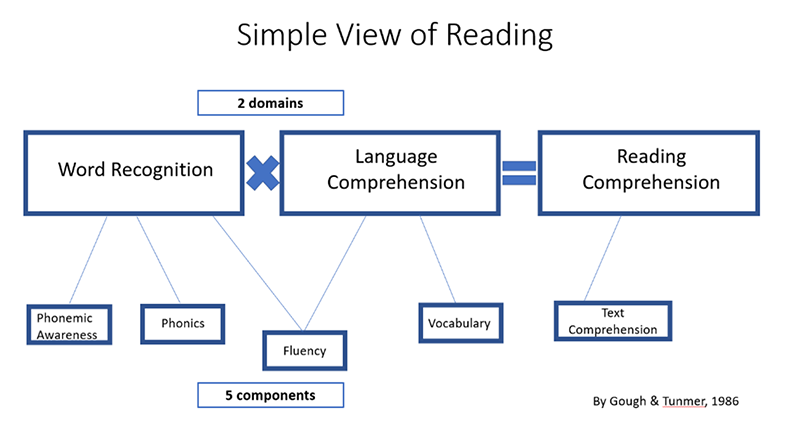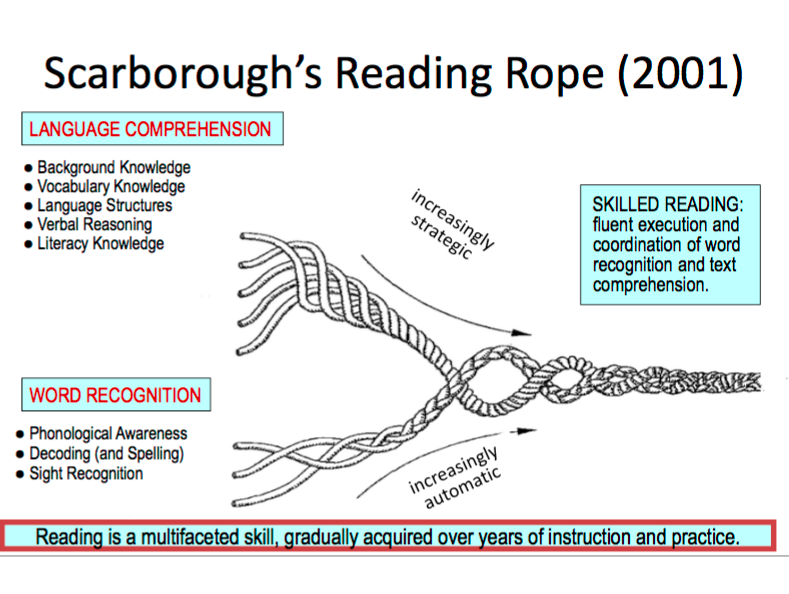Idaho’s approach to ensuring students develop strong foundational reading skills is based in the science of reading. The science of reading combines the findings from thousands of research studies across multiple disciplines that have converged to teach us how the brain learns to read and write, and why some students experience difficulty with these tasks. The implications of this research provide us with guidance on how to teach reading, indicating that all students must receive systematic, explicit instruction in language comprehension and printed word recognition in order to achieve proficiency.
“The science of reading is a vast, interdisciplinary body of scientifically-based research about reading and issues related to reading and writing.” - The Reading League. (2022) Science of Reading Defining Guide.
Simple View of Reading
The Simple View of Reading outlines the two dominant domains contributing to proficient reading and how the five components of reading (NRP, 2000) map onto these domains to help teachers know what to assess and teach. This view of reading acquisition aligns with the science of reading and the Idaho K-3 statewide early reading screener, the Idaho Reading Indicator (IRI), administered to all students.

Scarborough’s Reading Rope
The complex task of skilled reading is captured in “The Reading Rope” created by Hollis Scarborough. A reader’s language skills become increasingly strategic over time and word decoding becomes increasingly automatic weaving together the skills needed for fluent reading and text comprehension. Scarborough’s Rope can be used by educators to support skill instruction to ensure students become skilled readers.

The National Reading Panel (NRP) Report, published in 2000, identified and examined several essential components of reading instruction; phonemic awareness, phonics, vocabulary, reading comprehension, and fluency. Since the NRP report, research has continued to clarify and uncover additional knowledge and instruction that will help more of our students learn to read. Idaho recommends reading instruction in language comprehension and printed word recognition based on the solid body of research and includes the Five Essential Reading Components.
The Idaho Reading Indicator (IRI) is a kindergarten - grade 3 assessment. Idaho Statute 33-1806 requires that all public school students in kindergarten and grades 1, 2, and 3 have their early literacy skills assessed.
Learn more about the Idaho Reading Indicator.
Literacy: the ability to identify, understand, interpret, create, compute, and communicate using visual, audible, and digital materials across disciplines and in any context.
Reading: the process of simultaneously extracting and constructing meaning through interaction and involvement with written language. 2
Phonemic Awareness: The highest level of phonological awareness and is the ability to hear, identify, and manipulate the individual sounds in spoken words. 2
Phonics: The relationship between the sounds of spoken words and the individual letters or groups of letters that represent those sounds in written words.
Fluency: The ability to read text with accuracy, expression, prosody and comprehension.
Vocabulary: The words we must know in order to communicate effectively.
Comprehension: The ability to understand and gain meaning from what has been read.
2 International Literacy Association, n.d., “Literacy Glossary”
National Center on Improving Literacy
The Reading League: Access additional science of reading information, video series, and a call to action for educators, administrators, schools of education, publishers, policy makers, and parents.
Science of Reading: Dr. Mark Seidenberg Shares What Has Prevented Change in Schools
Teaching, Reading and Learning: The Reading League Podcast- Episode 12
Science of Reading: Emily Hanford Discusses How We Can Better Prepare Educators
Science of Reading: Lyncourt School District Shares Success
International Dyslexia Association: Access a structured literacy introductory guide, facts sheets, and infographics.
The Reading League list of recommended books.
YouTube Channels